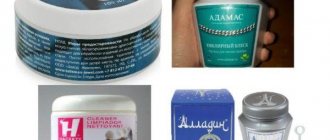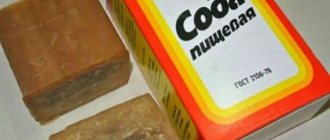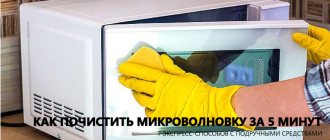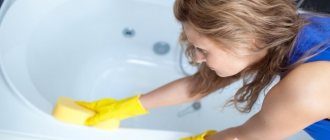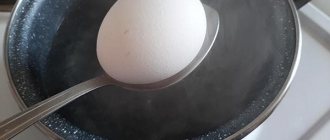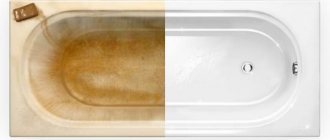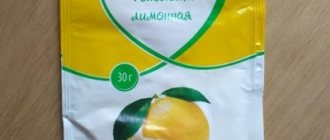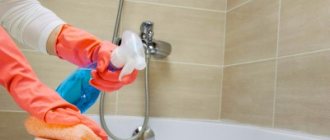A snow-white bathroom is the dream of many housewives. I'll tell you how to achieve it without spending a lot of time and effort. In most cases, the object of increased attention is the bath itself. Any plumbing fixtures can suffer from rust, yellowing, limescale and ingrained dirt if not properly maintained. The material of manufacture is not particularly important.
Causes and types of bath contamination
There can be several types of dirt on plumbing fixtures:
- Soap residue. It is formed as a result of the use of soap, gels, shampoos, balms, etc. This contamination is quite persistent, so you cannot simply wash it off with water. It can only be removed with cleaning compounds using a brush.
- Rust spots. The yellow coating on the walls of the bathtub is formed due to rust that accumulates in the water pipes.
- Limescale. Causes water that is too hard.
- Colored spots. They appear in most cases when coloring agents are used carelessly, for example, brilliant green, manganese solution, hair dye, etc.
- Dust. When renovating a bathroom, you should take care of the safety of the plumbing by covering it with film. Construction dust settles on the bathtub, after which it is difficult to clean it.
Removing soap scum
Soap foam, combining with the minerals that make up the water, forms persistent complexes that are difficult to remove when drying. By washing off the foamy sediment before it hardens, you will simplify the task of cleaning your bathroom and make it snow-white. Such plaque is more often formed when using solid soap due to the talc contained, which binds fat and calcium ions. You can prevent soap scum in your bathtub if you use liquid rather than solid soap.
If foam stones do appear in your bathtub, you can make it snow-white using a home remedy:
- citric acid crystals (10-15 g);
- hot water (200-250 ml).
Pour the lemon into a container with hot water. Soak a washcloth in it and spread the liquid over the bath in a thin layer. Instead of a sponge, you can use a spray bottle.
Wait a quarter of an hour and rinse off. Lemon solution destroys strong rocky joints and makes plumbing fixtures shine.
Traditional ways to clean baths
Preparing to clean the bathtub: important nuances
Before washing the bathtub from stubborn dirt and plaque at home, it is necessary to carry out preparatory measures and study all the intricacies. When choosing a cleaning method, it is important to consider the type of coating. The reaction of materials to cleaning agents varies markedly.
The following features need to be taken into account:
- You should not experiment with an acrylic bathtub, so as not to harm the outer glossy layer. It is forbidden to rub the bowl with metal brushes and hard sponges, as well as to use products with aggressive components.
- There are products designed for gentle cleaning. They are used for daily treatment so that the bath is always in good condition, but they cannot cope with old stains.
- Aggressive compounds, if used inappropriately, can lead to the destruction of the enamel or acrylic layer after several uses.
Cast iron bathtubs are considered more resistant to various types of influence. But even here it is important not to overdo it. Acidic substances must be used in doses, and a metal brush should not be used at all.
The most sensitive to dirt and household chemicals is acrylic. The material quickly absorbs dyes and is highly susceptible to mechanical stress.
This can't be done
There are many ways to damage your bathtub during cleaning. There are a number of rules that must be followed. Regardless of the material from which the bathtub is made, when cleaning it, do not use:
- Metal scourers;
- Hard wire plastic brushes;
- Metal brushes;
- Abrasive sponges;
- Scrapers and spatulas made of hard materials.
Always read the instructions for cleaning products carefully.
We recommend reading:
Types of bathtubs: What materials are there, their pros and cons.
If you use soda, do not heat it above +60°C. Do not dilute it in hot water. At temperatures above +60 degrees it disintegrates. The resulting sodium carbonate, if it comes into contact with the skin and mucous membranes, can cause irritation or dermatitis. In addition, it will not help clean the bathtub from dirt.
Soda ash belongs to substances of the 3rd hazard class. An aerosol of soda ash in contact with wet skin and mucous membranes of the eyes and nose can cause irritation, and with prolonged exposure, dermatitis.
Source
Important
Do not try to experiment with compositions. When some ingredients are mixed with household chemicals, harmful and toxic substances may be released. Others, on the contrary, may react and become useless, losing their cleansing and whitening properties.
Perform all methods of cleaning the bathroom as described, without violating the order of actions. There are many sites on the Internet that recommend, for example, mixing soda with vinegar or citric acid. If you do this, you will simply transfer the ingredients of the mixture and waste your time, because soda reacts with acids during the mixing process. You simply won’t have time to apply it to the surface to be cleaned.
Cleaning a cast iron bathtub
During use, old plumbing develops microcracks into which dirt is embedded. For this reason, cleaning a cast iron bathtub must be done frequently and with great effort.
Modern cast iron bowls are more practical because they have a special coating. Plumbing equipment is easy to care for - almost all oxygen-containing products can be cleaned.
Below are the most effective folk methods on how to clean a durable cast-iron bathtub until it is snow-white, and in 5 minutes or a little longer.
No. 1. Soda
The folk method has proven itself well.
- Prepare 2 types of soda in advance: baking soda and baking soda. Connect 1 to 1.
- Wet the bath and cover it with the resulting product.
- After 30 minutes, scrub with a washcloth.
- After 40 minutes, rinse with water.
No. 2. Washing powder
A cast iron bowl can be cleaned snow-white with a simple powder.
- The powder is rubbed into the walls of the bath and left for half an hour.
- The loose dirt is removed with a brush and the bowl is rinsed.
No. 3. Ammonia and soda
If you want to quickly clean a cast-iron bathtub from old deposits until white, use regular ammonia at home.
- Make a solution by mixing ammonia with soda (1 to 2).
- Apply to the walls of the bathtub.
- After half an hour, scrub and rinse.
No. 4. Vinegar and soda
Another folk method that has gained popularity because it perfectly removes dirt and returns the white color to the bath.
- Combine vinegar, baking soda, liquid cleaner (1:2:2).
- Rub the mixture into contaminated areas.
- Leave for a third of an hour, then remove with water.
Recommendations
- After the manipulations, the bowl must be washed with water and dried, wiping with a cloth.
- If the surface has microcracks, it is recommended to restore the plumbing, since in this case cleaning will not help get rid of stubborn dirt.
Recommendations for owners of cast iron bathtubs
It is worth taking into account the fact that enamel is a very fragile coating and not every cleaning composition is suitable for it. The product used should not contain aggressive or abrasive substances. Also, when cleaning, it is strictly not recommended to use brushes that are too hard.
Precautions and prevention measures
Wrongly chosen detergents can easily damage the surface, leave noticeable stains on it, and make the coating rough.
Such an oversight contributes to the appearance of many micropores through which dirt penetrates, settles deeply and accumulates. After this, the enamel becomes dull, yellowish, gray, and noticeable smudges appear on it.
Too hard metal brushes, fiberglass sponges, acid-containing and abrasive products lead to cracks and further destruction of the coating. Restoring enamel at home is quite difficult. Therefore, it is better to prevent the problem than to restore the bathtub later
Having run the bathtub to such a state, it will be much more difficult to cope with the pollution. If you follow the basic rules for using the product, take into account the manufacturer’s recommendations and use approved bath cleaning products that act without damaging the enamel, the coating will last for decades.
Here are some nuances to take note:
- Do not fill the container with excessively hot water (recommended liquid temperature is about 70 °C);
- it is undesirable to overload the bowl - on average, the maximum permissible weight of the product is up to 180 kg, but this figure may differ depending on the modification;
- It is forbidden to pour various chemical reagents into the bath;
- after each water procedure, it is necessary to rinse the surface with warm water;
- periodically, about once a week, you should wash the product using a regular soap solution and a soft sponge;
- if there are serious contaminants, you need to determine their type and select an appropriate cleaning agent that does not contain aggressive components or hard abrasive particles that can scratch the enamel;
- Do not try to scrape off with a blade or scrub away stubborn stains with hard metal brushes;
- After cleaning, you must thoroughly rinse off the composition under strong pressure, and then wipe the surface dry with a flannel cloth or soft towel.
It is highly recommended not to wash hard, metal objects in an enamel bath.
To prevent corrosion processes, you need to monitor the serviceability of taps and mixers installed in the bathroom. The slightest leak, left uncorrected for a long time, can provoke the appearance of deep rust.
If you find any chips in the coating, it is important to quickly repair them. Otherwise, rust will begin to form around the damaged area, which will eventually completely ruin the enamel.
To eliminate defects you will need fine-grained sandpaper, special putty or epoxy enamel. If the product is applied in several layers, the next layer can be applied only after the previous one has completely dried.
We talked in more detail about methods for restoring enamel in this material.
Tips for polishing the coating
The surface of a neglected cast-iron bathtub, which has ceased to shine and is covered with numerous scratches, can be revived by polishing. This procedure refreshes the appearance of the enamel well.
Polishing work is carried out in the following order:
- the surface is cleaned of contaminants using one of the methods proposed above;
- the clean coating is rinsed and wiped with a dry cloth;
- a special composition is applied to the enamel, intended for polishing paint surfaces, for example, car polish;
- The coating is polished, preferably using a sanding machine with a soft nozzle or manually with a microfiber cloth.
Once the surface of the bath begins to shine, you need to rinse it and wipe dry.
You need to understand that only a new layer of enamel can return the product to its flawless original appearance. But if you regularly take care of the coating and do not place objects inside that can damage the enamel layer, then the bathtub will look flawless for ten years or more.
Cleaning a steel bathtub
Steel is practical, but it is not recommended to use abrasive products for cleaning. The steel bowl is sensitive to high temperatures. Keep this in mind when choosing cleaning products. The reagent should not be allowed to heat up in contact with water.
No. 1. Ammonia
To clean the thicket, you need to make a liquid solution.
- Mix 1 tbsp. l. ammonia with 250 ml. water.
- Apply the product to the dry walls of the bath.
- After 10 minutes, the dirt is easily removed; all that remains is to rinse the bowl.
No. 2. Soda
We'll tell you how to clean a (steel) bathtub until it's snow-white in just 5 minutes with regular soda.
- Combine baking soda and water to form a paste.
- Distribute evenly and wait a little.
- Then carefully remove with a soft sponge, avoiding rubbing.
- Wash with water.
Recommendations
- Using traditional methods, wear gloves. If you do not follow the proportions, you can get a chemical burn.
- For steel coating, it is preferable to choose purchased gels. They are distributed and timed for 15 minutes, then removed with water.
- Regular Fairy liquid copes well with daily care.
Other folk remedies
The store has a huge selection of household chemicals that help in cleaning the bathroom. But many housewives trust more proven folk methods.
With their help, you can also remove stubborn stains and save money from the family budget. There are a lot of such recipes, but some of the main ones include the following:
- Soda ash and baking soda are mixed in equal proportions with a small amount of water until a homogeneous paste is formed. The resulting mixture is applied to the contaminated areas, and a pre-prepared solution of any liquid bleach with vinegar, taken in the same proportions, is poured over it. Leave for 20-30 minutes, remove with a sponge, slightly rubbing particularly stubborn stains. It must be remembered that this is an extremely aggressive cleaning method and can only be used on cast iron surfaces. If the bathtub is made of acrylic, it is better to use a more gentle product - wipe the stained areas with a napkin soaked in table vinegar.
- 1.5 tablespoons of citric acid are dissolved in a glass of water, the surfaces are wiped with this liquid - the method is applicable for enameled and metal types. If the bath is acrylic, fill it to the brim with water and add the same amount of citric acid and leave overnight. In the morning, drain the water and rinse.
- Take ¼ cup of lemon juice and dissolve borax in it until a paste forms. This mass is applied to problem areas and allowed to dry, then washed off with running water. If stains remain, repeat. Suitable for all surfaces and types of dirt.
- Hydrogen peroxide is mixed with any powder in a 1:1 ratio. The resulting paste is applied to the rust stains, left for 10-15 minutes and washed off with water.
- Ammonia and hydrogen peroxide are very suitable for cleaning enamel surfaces; mix them in a 1:1 ratio, then wipe the bath with the solution applied to a sponge and leave for 10 minutes, rinse with water.
- Dissolve soda and washing powder in warm water (1 tablespoon of dry ingredients per 500 ml of water), wipe all surfaces that require cleaning with the liquid, after 15 minutes treat with a brush or sponge soaked in hydrogen peroxide, and rinse with water.
- Laundry soap is grated and mixed with soda ash in equal proportions, adding a little water. The resulting solution is applied and left for 1 hour, rinsed with water.
Cleaning an enamel bathtub
Plumbing fixtures with such a coating are inexpensive and easy to maintain, which is why they are very popular. But before you clean the bathtub, you need to know one rule in order to carry out the procedure without harm to the enamel.
Avoid using hard brushes and abrasives. They wear away the enamel, the coating becomes rough, and microcracks form. Because of this, the appearance of the bathtub deteriorates, it acquires a yellow coating, and dirt quickly gets into the pores that appear.
What products can be used to clean an enamel bathtub:
No. 1. Lemon acid
To whiten the bath, use regular lemon juice.
- Prepare a high concentration solution based on citric acid.
- Treat the bath.
- Time it for a third of an hour and rinse.
No. 2. Ammonia and soap
Stubborn dirt can be easily removed with ammonia.
- Grate the entire piece of household goods. soap
- Place the shavings in water and leave until a homogeneous mushy state is obtained.
- Add ammonia (5 drops per ½ cup of soap).
- Treat the enamel surface.
- After a quarter of an hour, wipe with a sponge and rinse with water.
No. 3. Soda and peroxide
A popular method will help you clean an enamel surface until it is snow-white.
- 2-3 tbsp. l. mix soda with 250 ml. hot water.
- Add 50 ml. peroxide.
- To achieve snow-whiteness, you can add washing powder.
- After applying the composition to the walls, the dirt is easily separated.
- All that remains is to rinse the bowl with water.
Helpful information
Tips for caring for an acrylic bathtub:
When using any chemicals, rinse with cool, not hot, water. At high temperatures they increase their activity and can cause damage to acrylic.- Before using a detergent, you should carefully study its composition. It should not contain components that can destroy acrylic.
- You cannot mix several formulations at once unless indicated in the recipe. Multicomponent substances can accelerate the deterioration of the product.
- When washing the bathtub, you need to take care of the safety of the skin of your hands by protecting them with gloves.
All the most important and useful information about cleaning the bathroom is collected in this section of the site.
Cleaning an acrylic bathtub
Caring for acrylic bathtubs is not as difficult as it might seem. You just need to take into account that not all means are allowed to be used. Some of them can lead to irreversible damage to the coating, as a result of which contaminants will be absorbed into microcracks.
What not to do when caring for an acrylic bathtub:
- clean with products containing low-abrasive substances - after using powders, microcracks may appear, the coating will cease to shine and become dull;
- use chlorine-containing products that corrode the coating, making it rough;
- clean with hard brushes;
- clean the bowl with solvents, for example, acetone or oxalic acid, as they can lead to surface deformation;
- You should stop using formaldehyde and ammonia; an acrylic bathtub is too “delicate” for these substances.
In addition to the above reagents and abrasive components, acrylic plumbing is dangerous: alcohol, gasoline, acids, alkalis. When interacting with them, the color of the coating changes and microcracks form.
The list of restrictions is quite large, but for delicate coatings you can also find safe cleaning products at hand:
No. 1. Vinegar
It will not be possible to clean a bathtub with an acrylic coating until it is snow-white in 5 minutes, since after treating with vinegar you need to wait time. But the effect will impress you.
What should be done:
- Soak paper towels in the vinegar solution.
- Place on the walls and leave for a couple of hours.
- Finally, rinse with water.
No. 2. Lemon acid
Lemon helps maintain whiteness, removes yellow marks and old plaque.
- Fill the bath with water and pour acid (for 200 liters you will need 50 grams of lemon).
- After 2 hours, drain the water.
- Clean the plumbing fixtures with a sponge and wipe with a rag.
No. 3. Toothpaste
To quickly remove yellow stains and bring the bathtub to snow-white, use a paste or diluted powder to clean your teeth.
- Apply toothpaste in a 2 mm layer. on the walls of the bath.
- Detect for half an hour or longer if the dirt is ingrained and old.
- When the allotted time is up, rinse with water.
No. 4. Soda
This folk method involves using not soda itself, but a solution prepared from it with the consistency of a cream.
- Dilute the baking soda with slightly warmed water and allow the grains to dissolve.
- Next, add grated household ingredients. soap.
- Apply to the walls and bottom of the bathtub.
- After 30 minutes, rinse to remove dirt.
You can add aroma oil to the composition - the plumbing fixtures will not only become snow-white, but will also smell pleasant.
No. 5. Peroxide
An effective, but radical method, which is used when it is necessary to urgently clean the bathtub from stains.
- Prepare a solution of ammonia and peroxide (2:1).
- Wet the sponge and distribute the solution onto the stains.
- After 10 minutes, rinse with water. You can't hold it longer.
Ammonia should only be used in extreme cases. Interaction with this substance leads to damage to acrylic.
Why does the coating turn yellow?
Reasons for yellowing of the coating:
- Hardness of water. With a high content of calcium and magnesium salts in the water, a thin rough layer forms on the surface of the sanitary bowl. It is more friable than acrylic or enamel, so dirt, pigments and other coloring substances are easily retained in it. The dark film is removed from the bath along with a layer of mineral salts.
- Chlorinated water. Chlorine-containing solutions harm the acrylic coating, reducing its resistance to damage and contamination. Despite the low chlorine content, water saturated with it negatively affects the condition of the surface. It is especially dangerous for thin plastic liners and coatings formed from liquid acrylic.
- Rust in water. Corrosion of pipes in the general house system, heavy rainfall, repairs of water supply networks and poor water purification lead to an increase in the concentration of iron oxides. Rust gives the water a yellow tint and settles in limescale, pores and microdamages in the coating. Yellow or orange streaks may appear due to oxidation of the metal structure on the bowl (for example, the mesh on the overflow hole). Rust spots appear around deep scratches on the surface of steel and cast iron bathtubs.
- Soap and dirt deposits. If you do not wash and dry the bathtub after each use, a layer of skin particles, dirt, sebum and soap will form on its surface. Mixing with mineral salts, organic waste forms a durable film of gray or yellowish color.
- The use of products with natural or synthetic pigments. Hair dyes, tonics, coloring masks, henna and herbal infusions can turn the coating yellow, light brown or rusty. Decoctions of oak bark, saffron, turmeric, onion peels, walnuts, etc. have strong coloring properties.
Improper surface care (abrasive cleaning, use of acids and alkalis) damages the coating and accelerates the formation of plaque. Strong reagents can quickly clean off any dirt, but complicate cleaning in the future.
No. 1. Universal products for daily bathroom care
This category contains compounds that are used regularly without harm to enamel or any other coating. Universal products are good because they act simultaneously in all directions: they remove yellow plaque, eliminate rust and other contaminants that tend to eat into the surface.
Sanelit
A budget product in the form of a gel with a whitening effect has proven itself to be excellent. The composition contains active oxygen and fruit acids, thanks to which Sanelit removes almost all types of dirt (soap stains, rust and limescale).
The undeniable advantage of the product is its versatility. It is used on all surfaces, including acrylic, enamel, and plastic bathtubs. The product also removes stains on chrome products and ceramics. There is no unpleasant odor and it is quite economical to use.
SunClean
SanClin will help you clean your bathtub until it’s snow-white, removing all dirt in 5 minutes, and carry out basic plumbing care. The product eliminates soap residue, rust marks, and yellowness. The composition does not contain abrasives, acids, or phosphates, so they are allowed to clean acrylic bathtubs, glass and mirrors.
Luxus Professional
The spray product is ideal for use in the bathroom. The products have quality certificates and a lot of positive reviews.
Advantages:
- delicately cares for sensitive enamel and acrylic surfaces;
- after application, it gradually thickens, flows down, and an active cleaning layer forms on the coating;
- quickly removes residual grease, soap residue, limescale and other contaminants.
Made in Germany, the product justifies its price. It destroys bacteria and gives freshness.
Luxus Professional is produced in accordance with eco-technologies. After use, the product decomposes into non-hazardous biological substances.
Bottom line
Everyone knows the wisdom that any problem is easier to prevent, so we adjust our methods of caring for the device so that later we don’t have to shed burning tears over a ruined bathtub.
- After each use, rinse the bowl and wipe dry.
- Wash it every day with a mild specialized composition or dishwashing detergent.
- Remove any dirt immediately, without allowing it to “eat” into the surface.
- Install a pre-filter to remove impurities and rust from tap water.
But if trouble could not be avoided, and unsightly stains, plaque and rust still settled in your font, do not be upset. Now you know what and how to do to make the product white again.
If you have your own bathroom whitening method, then don’t be shy and share your secret in the comments!
No. 2. Household chemicals for cleaning bathtubs from rust
Special products help both clean the bathtub from rust and plaque, and keep the plumbing at home clean for a long time. Household chemicals even remove old dirt, stubborn rust and limescale that cannot be removed by daily care products.
Effective compositions that will return snow-whiteness to the bath:
Sanox gel
The active components in the product help quickly remove rust and old limescale. In just a few minutes the bath will become snow-white again. In addition, the product kills pathogens of intestinal infections.
Sanox gel contains oxalic acid, so it cannot be used on acrylic and enamel. You need to use the product with gloves, the frequency of use is maximum once a week.
Cillit Bang
The cleaning product, known thanks to advertising, removes all types of dirt in a short time. It is used to whiten bathtubs from yellowness and rust. The effect can be achieved thanks to oxalic acid in the composition. Please note that the product has a strong odor.
Features of removing certain contaminants
It all starts with preparation. The result depends on how well it is carried out. Personally, I had a hard time deciding on a detergent. The extensive assortment that is presented today in household chemical stores has become a factor that has significantly complicated the task. Therefore, based on my experience, I can give some useful advice.
Before going to the store, go into the bathroom and really assess the current situation. To solve the problem, you will need the following initial data:
- the material from which the bathroom is made;
- type and age of spots.
If there are contaminants of various origins, preference should be given to universal formulations: Cif, Domestos without chlorine.
The bathtub must be washed after each use. Cleaning should be done several times a month using professional products. In this case, you should follow the instructions for use that come with them.
If stains do appear, you need not only to take measures to eliminate them, but also to neutralize the cause. Otherwise, the problem will become “chronic”. How to deal with the most common pollution at home is indicated in the table.
| Stain type | Options |
| Residue of grease and soap | A thick paste of baking soda. |
| Yellow streaks | Fresh lemon juice. A mixture of baking soda and soda ash. Dry bleach mixed with water. This method is not suitable for cleaning acrylic coating. |
| Limescale | A mixture of baking soda and lemon juice. |
| Mold | For processing, it is allowed to use ammonia, vinegar, borax and hydrogen peroxide. A composition of white and activated carbon gives a good effect. |
How to clean a bathtub from potassium permanganate and brilliant green
I am sure that these medicines are in every home. The only drawback among their many advantages is the persistent coloring effect. When brilliant green and potassium permanganate get on plumbing equipment, characteristic stains form, which are quite difficult to get rid of.
Potassium permanganate can be washed with a mixture of lemon juice (or acid) and hydrogen peroxide.
Traces of brilliant green are removed with alcohol. This method will not have the desired effect if the bathtub is made of acrylic. But there is no need to be upset; over time, the contamination will go away on its own.
How to clean a bathtub after renovation
To prevent stains and damage to the protective layer, I always cover the bathtub before starting work. If the problem could not be avoided, an ambulance will be required. The cleaning agent should be selected based on the cause of the contamination.
To remove silicone, paint and grout, you can use aggressive solvents. These include solvent, white spirit, acetone and gasoline. Lime mortars are removed using special products, for example Duty Extra. It should be taken into account that such treatment will negatively affect the condition of the acrylic and enamel coating. The sooner the cleansing is carried out, the better the result.
The sealant is designed for more reliable fixation of seams and joints. To remove it from the surface of the bathtub, you should purchase professional compounds. If this is not possible, you can use folk remedies. They should include table salt.
No. 3. Store-bought bath cleaners for snow-white bathtubs
Let's look at how to clean a bathtub so that it shines white. You can restore the shine and original appearance of your plumbing fixtures using products specially designed for this purpose. They are relatively inexpensive and easy to use at home.
CIF Ultra White
The effective mousse is very popular because it is inexpensive. The composition includes tiny cleaning granules surrounded by bubbles, so that dirt quickly dissolves.
Consumers note the cumulative effect - as soon as you clean the bathtub, it becomes even whiter after each use of the product. The cream does not provoke the formation of scratches and soap stains.
The advantages also include: a pleasant smell, ease of use, elimination of old limescale and dirt.
Bagi Acrilan
It has several actions: removes mold, rusty plaque, stubborn dirt, and pathogenic bacteria. The indisputable advantage of the product is that it allows you to clean the bathtub until it is snow-white quickly, stains disappear in 5 minutes, and the plumbing fixtures acquire a beautiful shine. Among the disadvantages, consumers highlight the high price and surfactant content.
Preparation
Before you rush into the embrasure and attack the bowl with all sorts of powders, gels and acids, you need to find out two things: what material is your bathtub made of and what caused the contamination.
The first will help you choose the right products that will not damage the surface. For cast iron, acrylic and steel appliances, different methods must be used. And here you should be very careful and attentive, including when choosing household chemicals. Since not every bottle labeled “Bathroom” is suitable, the composition must be developed for a specific material.
You need to be even more picky about people's advice and recommendations from forums. Because the stain can be washed off, but how will the material react to this, and will it be necessary to change the font after a year or two of such use? This is a big question to which no one is likely to give you a guaranteed correct answer.
The reasons for contamination can be different: you washed colored linen and the paint was absorbed into the pores, you haven’t cleaned the device for a long time and there is an “indelible” edge, a metal object has been lying on the edge for a long time and rust remains. Each of these problems may require an individual solution.
The most common reasons are:
- Poor water quality - high salt content forms limescale deposits.
- Condition of communications - rust in the pipeline leaves its traces.
- The use of various hygiene products - soap, shower gel, shampoo - forms a soapy layer, which gradually turns into difficult-to-remove stains.
No. 4. The safest bath cleaners
In homes where small children or people with allergies live, it is recommended to clean the bathtub with hypoallergenic products. They are made from biodegradable ingredients and natural substances.
Frosch "Green Grapes"
Based on grape acid and tensides. The spray does not have a strong odor, and the bottle has a child safety lock. Frosch is often purchased by allergy sufferers, asthmatics and those who prefer environmentally friendly products. To whiten the bathtub, the emulsion must be applied for 10-30 minutes, depending on the nature of the contamination.
Amway Bathroom Cleaner
Before you whiten your bathtub from yellowness using available methods at home, read about the effective composition from Amway. The Belgian company produces safe cleaning products. The gel does not contain acids or chlorine and can be used for daily care. There is no pungent odor and no harm to the coating.
Astonish paste
The paste is intended for the care of kitchen surfaces, but it is often used in the bathroom. Contains soap and mild abrasives.
Advantage:
- effective and gentle action;
- affordable price;
- high quality;
- efficiency.
Astonish paste is difficult to find in regular stores; it can be ordered online.
What can't be used and why?
To wash an acrylic bathtub, you cannot use the following products:
- Acetone. It can lead to thinning of the acrylic layer and rapid wear of the bathtub.
- Abrasive substances. This applies not only to cleaning powders, but also to regular soda. It can only be used in diluted form. The use of abrasive compounds contributes to the appearance of scratches.
- Highly concentrated acids, for example, vinegar essence.
- Paint thinners, gasoline.
- Boiling water. To prevent acrylic from cracking, the water temperature should not exceed 60 degrees.
- Chlorine and cleaning products based on it. Its use leads to the formation of pores, which reduces the service life of the product.
- Formaldehyde. These substances are not only toxic, but also completely incompatible with acrylic.
How to keep your bath white after cleaning: useful tips
To keep your plumbing fixtures clean and shiny longer, and to avoid having to get rid of old stains, pay attention to the following tips:
- It is recommended to clean the walls of the bowl with a damp, soapy cloth after each use, and then rinse with warm water.
- After use, wipe the plumbing fixtures dry.
- To avoid rust, you must ensure that there are no leaking taps.
- Do not use metal sponges, hard brushes or powders with hard granules for cleaning. Do not scratch the surface - the more microcracks on the bowl, the faster dirt will appear on it, which is difficult to wash off.
- If the bathtub is used for washing metal products or bathing pets, to protect the coating from scratches, a special rubber mat should be placed on the bottom.
- If it is not possible to wash and wipe the bathtub every day, it is recommended to apply a glass cleaner, for example, Amway, Tilex, Titan, to the coating. They help break down lime and grease, preventing the formation of dark spots. The disadvantage of such products is the constant smell of chemicals in the bathroom. This recommendation is only useful to people who take a shower and do not use the bath.
We've looked at all the possible ways to clean your favorite bathtub until it's snow-white in 5 minutes or a little longer. Of course, it is much easier to prevent the occurrence of persistent stains than to remove them. To maintain the original whiteness, you need to clean the plumbing fixtures once a week with a folk remedy or a store-bought solution.
Required accessories
To clean the bathtub with folk remedies you may need:
- Soft sponge;
- Dry rags;
- An old toothbrush with soft bristles;
- Kitchen scales
- Measuring container;
- Latex gloves.
If you want to use special household chemicals, you need to protect yourself from them. Bathtub cleaners can be quite aggressive. Use goggles and a respirator. Change into old clothes that you don't mind - some substances, if they come into contact with the fabric, can discolor or damage it.
How to remove yellowness
Regular cleaning of the bathtub must be performed not only for aesthetic reasons, but also in order to maintain hygiene and sanitation rules, because headaches, irritation of the respiratory tract, itching and other signs of deteriorating health can be the consequences of contamination of this plumbing.
To easily clean a bathtub made of any material at home, you need to choose the right cleaning products. But there are also universal care recommendations that are suitable for any type of plumbing. By following them, you will not damage the coating of the product.
- When cleaning the surface of the bathtub, you should never use metal brushes - they deeply scratch any coating, which can subsequently cause cracks to appear.
- You should not clean yellow toilet bowl gel, which is designed to remove lime deposits - it contains aggressive substances, as well as acid, which can damage the integrity of the acrylic or enamel coating.
- Do not soak laundry with powder in the bathtub, because particles of this detergent can corrode the top layer of coating.
- As with any other task, you shouldn’t go to extremes with cleaning - daily cleaning of the bathtub is not only an unnecessary task that takes up precious time, but also has a harmful effect on the plumbing itself. Enameled and cast iron devices should be cleaned once every 6-7 days, and acrylic ones - once every 12-14 days.
- After each use, the bath should be rinsed with warm water and wiped dry with a soft cloth; this simple rule will make it easier to cope with yellow plaque in the future.
Advice : always remove metal objects from the bathtub - they deteriorate from moisture and contribute to the appearance of yellowness on it, and subsequently the formation of corrosion, which will damage the coating.
As for individual recommendations for cleaning bathtubs made of different materials, we will dwell on this in more detail later in the article.
Reviews
Alina, 20 years old. I recently got married, my husband and I moved into my grandmother’s old apartment. The bathtub was in a deplorable state. My mother recommended a tried and true remedy: whiteness. But I found a detailed article on the Internet. From it I learned that soda is also used quite actively for cleaning the bathroom. I washed all the plumbing with a mixture of baking soda and citric acid. The result simply shocked me. The old bathtub shone like a freshly minted coin!
Anna, 40 years old. I always buy Domestos at the supermarket. A week ago I decided to completely redo my bathroom. The cleanser ran out at the most inopportune moment: I didn’t have time to clean the dark stain on the bathtub. Ordinary food water with vinegar helped me. The stain disappeared as if it had never existed. Now I'll wait to buy new plumbing fixtures. I’d rather order an elegant, fitted coat from a fashion catalogue, which I’ve been dreaming of for a long time.
Secrets of cleaning the iron using soda.
Crystal white
Chemical bleaches enhance the effect of soda.
For example, one of the most effective means is “Whiteness”.
It must be applied to the surface after cleaning the bath with sodium bicarbonate. The duration of exposure is approximately 30 minutes.
Attention! “Whiteness” copes well with smudges and stains, and eliminates darkening of the enamel. It is recommended to use it no more than three times a month, otherwise you may harm your health.
“Whiteness” is sold in the hardware department of the store. Its main component is sodium hypochlorite.
The product is also used for bleaching linen, washing porcelain or earthenware dishes, and disinfecting toilets.
Bleach helps eliminate the unpleasant odor coming from the trash can.
How to clean acrylic at home
Acrylic bathtubs, with their appearance on the market, successfully replaced cast iron bathtubs, which were previously considered the best and were the most in demand. And all this is thanks to the plasticity of the material, which can take any shape, its lightness, high thermal insulation properties, as well as hygiene.
Advice : in order for your acrylic bathtub not to deform and serve you for many years, you should not expose it to high temperatures (acrylic is unstable to them), namely, you should not soak things in boiling water in it, place hot objects on the surface, or smoke in it. in the bathroom.
For a long service life of an acrylic bathtub and maintaining its snow-white appearance throughout this time, it is necessary to correctly select household chemicals that are suitable for this material. It is advisable to wash acrylic products with gentle care products, excluding aggressive ones. You can use dishwashing and shower gels, as well as regular liquid soap. And for cleaning sanitary ware, such specialized products as Acrylan, Cif, Mister Chister, Acryl Star, Acrylic Polish, etc. are perfect.
It is also necessary to follow the correct procedure for washing acrylic bathtubs. A step-by-step description of this process is presented below:
- First, you will need to moisten the surface of the product with warm water, since you cannot clean an acrylic bathtub dry, so as not to damage it.
- Next, you need to put on gloves and precisely apply the detergent to particularly dirty areas, as well as to a sponge or soft cloth.
- We distribute the product over the entire plastic surface, paying special attention to areas with the most persistent stains, which can be additionally sprinkled with alcohol, lemon juice or vinegar.
- Leave the treated acrylic bath for about an hour.
- After this time, thoroughly rinse off all products and wipe the surface dry with a clean soft cloth.
If you own an acrylic whirlpool bathtub, then this product must be washed as follows:
- Take warm water and stir the detergent in it. Run the hydromassage function for about 15 minutes.
- Turn off the system and leave the cleaning solution for another 10 minutes.
- Next, drain the washing mixture and collect clean water without adding any drugs to it. Start the hydromassage again for 5 minutes.
- Then drain all the water and wipe the bathtub dry.
The Jacuzzi requires mandatory care after each use, which consists of rinsing and then completely drying the surface with a lint-free cloth. Also, to prevent the formation of scale and the accumulation of contaminants, monthly and annual maintenance of this equipment is required, which is most often performed by specialists.
Important : in order not to clog the hydromassage system, this function should be used without bath gels and foams. This will help maintain the technical health of your device for a long time.
How to clean a bathtub with vinegar?
How to clean a bathtub with vinegar?
Vinegar has long been used to disinfect and clean kitchen utensils and plumbing fixtures. If you use it, for example, together with soda, you will get an effective cleaning agent - gentle on the surface and not harmful to health. How to clean a bathtub with vinegar? Recipe:
- First, apply a paste of baking soda and water to the surface of the bathtub. After 20 minutes, apply 9% vinegar over the soda mixture. The vinegar will immediately react with the baking soda. It helps to cope perfectly with any plaque on white enamel.
When 30-60 minutes have passed, rinse off the baking soda and vinegar with water and wipe the surface with a napkin.
